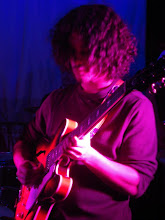A combination of different inspirations has led me to a very specific rhythmic problem. I’ve been listening to a lot of recently composed classical music which is influenced by Indian rhythms. There is a lot of polyrhythms, of long beat cycles etc. One thing I’ve noticed is that typically we see the play of 8th notes grouped into 2s and 3s, we see triplets, and duplets, and we see things like a rhythmic pattern consisting of an odd number of subdivisions superimposed over another rhythmic figure consisting of an even number of subdivisions, causing one to feel displaced.
All these things are great compositional and improvisational tools, but they will serve us another purpose here. It’s hard sometimes to go into double time. But what about triple time? Mitch Haupers showed me a very useful exercise that involved a section of his book Factorial Rhythms dealing with rhythms in 6/4.
Using a metronome play what is written with the click representing the quarter note. Continue on to playing the 6/4 rhythm again with the click playing the half note. And then the third time the click will represent the dotted half note (triple time). This poses some interesting problems because the same rhythm may sound at one speed as 2 groups of 3 and at another speed as 3 groups of 2 which makes this especially disorienting.

Of course, it should be obvious in hindsight why Mitch very wisely chose to expose us to this kind of exercise using 6/4 rhythms. Look at how beautifully the rhythm fits into all 3 times. If he’d started with what I’m about to show you next, it would have been a little too much (hint).
What I’ve been seeing a lot of in the repertoire I’ve been studying and that seems like a natural extension of this exercise, is how to play 3/4 rhythms in the span of 2 or 4 beats,. What I haven’t been seeing is the MUCH harder problem of how to play 4/4 rhythms in the span of 3 beats.
Let’s start with 3 over 2 or 4. The division is actually quite simple. To divide 2 beats into 3 is a quarter note triplet. But to understand them more precisely we need 8th note triplets.

Now here’s where the real problem starts. These rhythms in themselves are easy enough to play with a bit of practice, but now we’re talking about superimposing rhythms over other rhythms. So let’s look at the tuplet as a structure over which we can hang a new pattern. This is going to become a more complicated polyrhythm because it is going to involve a full blown metric modulation superimposed over the original rhythm.
Let’s take putting 4 over 3 like I said we would. We need to divide the 3 beats into 16th notes, and then group those into 3s.

Now we get into a problem which could arise with the previous examples as well, come to think of it. As you can see, to superimpose 4 quarters in the space of 3 results in 4 dotted 8th notes. But what now if we wish to play a measure of 4/4 over a bar of 3/4. yikes! Now we’re going to have to have to use dotted 16th notes to represent the 8th note from the bar of 4/4.
The trouble, whether you try and think it through to exact mathematical values, or just feel your way through, is how to take something which you’re feeling as a natural division of 3 (such as the dotted 8th) and play a duplet over it (the dotted 16th). Now you have duplets which completely obscure where the original beat used to be, which is why we’re forced to write things out as they are in the middle of the 3 bars below.
It feels like we’re playing duplets in 12/8, and then superimposing THAT over 3/4. Ouch.



No comments:
Post a Comment